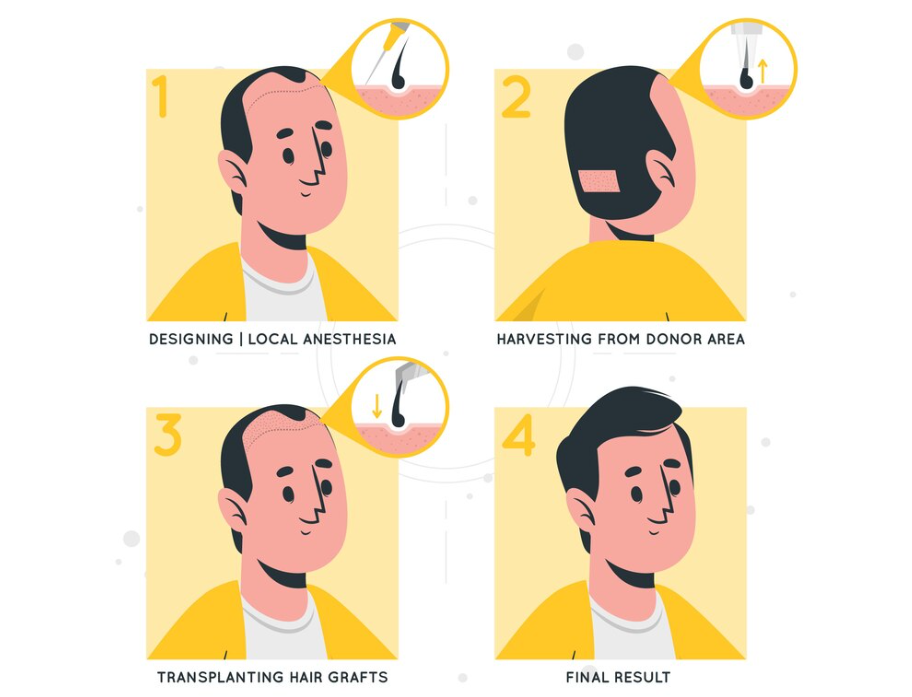What is Hair Graft?
Table of Contents

What is Hair Graft?
Hair loss can be a source of distress for many individuals, affecting their self-esteem and confidence. Fortunately, modern hair transplant techniques offer a solution to restore a full head of hair. At the heart of these procedures is the concept of hair grafting. In this article, Dr. Terziler, a renowned expert in hair restoration, explains what a hair graft is and its crucial role in hair transplants.
Understanding Hair Grafts
A hair graft is a small piece of skin containing one or more hair follicles that is removed from a donor area (typically the back or sides of the head) and transplanted to an area experiencing hair loss. These grafts are the building blocks of hair transplant surgery, allowing surgeons to redistribute hair to areas where it’s needed most.
Types of Hair Grafts
- Single Follicular Unit (FU): Contains 1 hair follicle
- Double FU: Contains 2 hair follicles
- Triple FU: Contains 3 hair follicles
- Quadruple FU: Contains 4 or more hair follicles
The Role of Hair Grafts in Transplants
Hair grafts play a pivotal role in creating natural-looking results in hair transplant procedures. By carefully extracting and placing individual grafts, surgeons can:
- Mimic the natural hair growth pattern
- Create a seamless blend with existing hair
- Achieve optimal density in thinning areas
- Design a customized hairline that suits the patient’s facial features
Grafting Techniques
At Dr. Terziler Exclusive Clinic, we utilize advanced grafting techniques to ensure the best possible outcomes for our patients:
1. Follicular Unit Extraction (FUE)
FUE involves extracting individual follicular units directly from the donor area using a specialized punch tool. This technique offers:
- Minimal scarring
- Quicker recovery time
- Flexibility in graft placement
2. Direct Hair Implantation (DHI)
DHI is an advanced technique that allows for simultaneous extraction and implantation of hair grafts. Benefits include:
- Increased precision in graft placement
- Reduced time outside the body for grafts
- Potentially higher graft survival rate
3. Robotic DHI
As a pioneer in hair transplant technology, Dr. Terziler Exclusive Clinic is proud to offer Robotic DHI, the most advanced hair transplant technique available. This innovative method combines the precision of robotics with the expertise of our surgeons to provide:
- Unparalleled accuracy in graft extraction and placement
- Minimized human error
- Faster procedure times
- Optimized graft survival rates
Benefits of Hair Grafting
Hair grafting offers numerous advantages for individuals seeking to restore their hair:
- Natural-looking results: Grafts are placed to mimic natural hair growth patterns.
- Permanent solution: Transplanted hair is resistant to further loss.
- Improved self-confidence: Restoring hair can significantly boost self-esteem.
- Versatility: Can be used to restore hair on the scalp, eyebrows, and beard.
- Minimally invasive: Modern techniques result in minimal scarring and quick recovery.
Understanding hair grafts is crucial for anyone considering a hair transplant. At Dr. Terziler Exclusive Clinic, we leverage our expertise and cutting-edge technology to provide the best possible outcomes for our patients. Whether you’re dealing with a receding hairline, thinning crown, or more extensive hair loss, our team can create a personalized treatment plan using advanced grafting techniques to help you achieve the full, natural-looking hair you desire.
If you’re considering a hair transplant or want to learn more about hair grafting, don’t hesitate to contact Dr. Terziler Exclusive Clinic. Our team of experts is ready to guide you through the process and help you make an informed decision about your hair restoration journey.
How many hairs are in a single graft?
Each graft can contain 1 to 4 hair follicles, depending on the extraction method and the individual’s natural hair characteristics.
Where are hair grafts taken from?
Hair grafts are usually harvested from the donor area at the back or sides of the scalp, as these hairs are more resistant to hormonal hair loss. In some cases, body hair (e.g., from the beard or chest) may be used.
How many grafts are needed for a hair transplant?
The number of grafts required depends on the size of the bald area, the desired density, and the patient’s hair characteristics. Typically, 1,000 to 4,000 grafts may be transplanted in a single session.
Is the process of graft extraction painful?
No, the process is not painful as local anesthesia is applied to the donor area during graft extraction. Patients may feel slight discomfort during recovery.
Can all grafts survive after transplantation?
Not all grafts survive after transplantation, but a skilled surgeon can achieve a survival rate of 90% or higher by using proper techniques and ensuring optimal handling of the grafts.
What happens to the donor area after grafts are removed?
The donor area heals within a few weeks. In FUE, small dots are left that are barely visible, while FUT may leave a linear scar that can be hidden by surrounding hair.
Why is the quality of hair grafts important for a successful transplant?
High-quality grafts ensure better survival rates, natural-looking results, and long-term hair growth. Proper harvesting, handling, and placement of grafts are essential for the success of a hair transplant.













